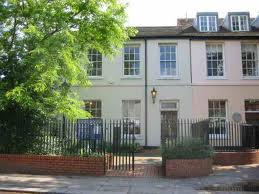 Barnet Museum
Barnet Museum Church Farmhouse Museum NOW CLOSED
Church Farmhouse Museum NOW CLOSED Golders Green Crematorium
Golders Green Crematorium High Sports Hendon
High Sports Hendon Museum of Domestic Design and Architecture (MoDA)
Museum of Domestic Design and Architecture (MoDA) Royal Air Force Museum London
Royal Air Force Museum London The Jewish Military Museum
The Jewish Military Museum Topsy Turvy World
Topsy Turvy World
Barnet Museum was opened in March 1938 at 31 Wood Street, to house the collection of the Barnet & District Local History Society . Its building is an attractive early Georgian house in the heart of Chipping Barnet. The Museum contains archives, objects, prints, photographs, paintings and maps reflecting the development of Chipping Barnet and the surrounding area, as well as a notable collection of period costumes and accessories, domestic items and lace.
History of Barnet Museum
Barnet Museum was opened in March 1938 at 31 Wood Street, to house the collection of the Barnet & District Local History Society . Its building is an attractive early Georgian house in the heart of Chipping Barnet which lies about 11 miles north of the centre of London.The Museum contains archives, objects, prints, photographs, paintings and maps reflecting the development of Chipping Barnet and the surrounding area, as well as a notable collection of period costumes and accessories, domestic items and lace.
Chipping Barnet grew up around an important junction of Wood Street, and the road that was later to be known as the ‘Great North Road'. Traffic on the new road lead to the development of a large number of busy coaching inns. Barnet also became known both for its market and for its fair. (The word ‘chipping' comes from the Anglo-Saxon ‘cheap' which means ‘market', and ‘Barnet Fair' became the Cockney rhyming slang for hair.) Charters for the market and fair were granted in 1199 and 1588 respectively.
In addition to the town of Chipping Barnet the museum covers other nearby areas. One of these is East Barnet, which formed part of the original manor of Chipping and East Barnet it is the latter that appears to have been the focus of the earliest settlement. The parish church of St Mary the Virgin, East Barnet dates from the first half of the eleventh century, whilst the church of St John the Baptist in Chipping Barnet dates from around 1250. The town of New Barnet was created following the coming of the Great Northern Railway in 1850. Other areas that are covered by the Museum include West Barnet, Cockfosters, Arkley, Hadley, Whetstone and Totteridge.
A notable battle was fought at Barnet on East Sunday 1471. It was one of the final engagements in the Wars of the Roses, and saw the death of the powerful Earl of Warwick (known as the ‘Kingmaker').
As a major stopping point on the route out of London and a place where spring waters were available. Barnet has been visited by many famous people. From kings and noblemen to poets and authors, they have included Arbella Stuart (grand-daughter of Bess of Hardwick), Samuel Pepys and Charles Dickens.
Barnet was in Hertfordshire until 1965 when it became part of the newly formed London Borough of Barnet. The Museum building is owned by the Borough, whilst the collection belongs to the Barnet & District Local History Society, whose volunteer members run the Museum itself.
No Comments Yet - Why not be the first to leave a comment
Every effort is made to make sure that all the information is correct but we strongly recommend that you call Barnet Museum before you set off on your day out to confirm opening times and admission prices.
Please also note that the position on Google maps for Barnet Museum is a rough estimate using their postcode in the database and might be slightly out.
It may also be worth clicking the web link for Barnet Museum to see if there are any special events coming up or currently on.